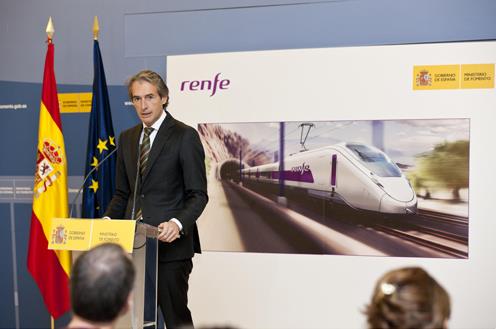
The Minister for Public Works, Íñigo de la Serna, announced the many benefits that will be made available to passengers as a result of the contract awarded to Talgo to build 15 new high-speed (AVE) trains, including their maintenance for 30 years, for a total sum of 768.5 million euros.
The tender decision also provides for the option to build another 15 additional high-speed trains and the extension of the maintenance period for another 10 years.
The future high-speed train
With the new high-speed trains, Spain will have the most modern fleet in Europe, with state-of-the-art trains, all provided with the most modern technology (including WiFi), which have a high capacity and are versatile, accessible and reliable.
High-capacity train
The Talgo proposal will result in a high-capacity train, with a total of 521 seats, of which 416 will be in economy class, with the remaining 105 in business class. These seats will be distributed in rows of 2+2 in business class and of 3+2 in economy class. All seats may be adjusted to face the direction in which the train is travelling.

The train will provide LED screens on which it will be possible to access the new Play Renfe application and enjoy an extensive offer of Renfe entertainment and other services.
Great versatility
The seats will run on floor rails, which offers great versatility in the configuration of the different classes of offer. Moreover, the future train will offer the possibility of dividing the compartment into different ambient segments, through the use of panels, as can be seen in the photograph below.
Extensive luggage space
The trains will have up to 206 litres of luggage space per passenger, with the possibility of placing luggage under the seats, as can be seen in the photograph below.
Unaided access train
As part of its commitment to the accessibility of the train, and within the Corporate Social Responsibility strategy of Renfe, which it has been working on for many years, the company highly assessed the fact that all the compartments of this train, including the cafeteria, provide unaided access, with the floor of the train placed at the level of the platform, as can be seen in the photograph below.
Cutting-edge signalling and safety technology
From a technological point of view, these trains have the most advanced signalling and safety systems (ERTMS, ASFA Digital, STM LZB, STM TVM and KVB) and can travel at up to 330 kilometres per hour. Patentes Talgo offers a guarantee period of five years and a high availability of the fleet.
Joint maintenance with Renfe
The maintenance of these future high-speed trains will be carried out by a joint venture with Renfe, which will allow the company to guarantee the maintenance of the know-how of this process and the workload for the workshops of the company Renfe Integria Fabricación y Mantenimiento S.A., a company 100% owned by Grupo Renfe. The first trains will be certified within between 38 and 42 months.
Improvement on initial tender price
Following Monday’s award to Patentes Talgo, Renfe has obtained a significant improvement on the initial tender prices quoted in the terms and conditions for this project. Hence, the offer made by Talgo to manufacture the first 15 trains and their maintenance for 30 years amounts to 786.5 million euros, which is a 28.2% improvement on the initial tender price quoted in the terms and conditions. The extension to the contract of an additional 15 units and to carry out the maintenance for a total of 40 years (10 years plus those provided for in the initial part of the tender contract) represents a global investment of 1.49 billion euros, a 43% improvement on the initial tender price quoted in the terms and conditions.
Job creation
The manufacture of the trains will create some 1,000 direct and indirect jobs for five years. Their maintenance will create some 100 jobs per annum for the life of the contract (30 and 40 years), all of which will give a major boost to the activity of the national industry sector.




